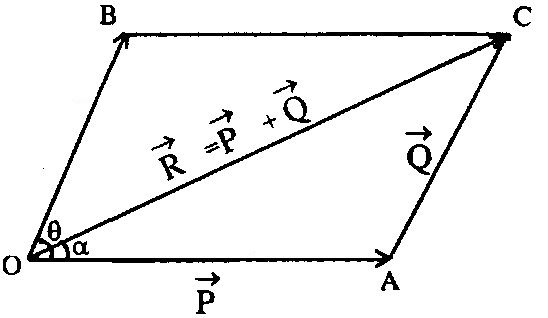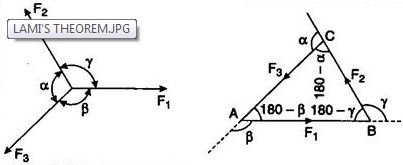Definition
Zero vector
A zero or null vector is a vector whose magnitude is 0 and has unspecified arbitrary direction. For example when a body projected vertically from the ground returns to the ground, its vertical displacement is a zero or null vector.
Definition
Triangle Law of Vector addition

Triangle law of vector addition states that when two vectors are represented by two sides of a triangle in magnitude and direction taken in same order then third side of that triangle represents in magnitude and direction the resultant of the two vectors.
Definition
Parallelogram Law of Vector Addition

Parallelogram Law of Vector Addition states that when two vectors are represented by two adjacent sides of a parallelogram by direction and magnitude then the resultant of these vectors is represented in magnitude and direction by the diagonal of the parallelogram starting from the same point.
Example
use of parallelogram method of vector addition

Parallelogram method of vector:
If two vectors acting at a point are represented in magnitude and direction by the two adjacent sides of a parallelogram, then their resultant is represented in magnitude and direction by the diagonal passing through the common tail of the two vectors.
Hence magnitude and direction of resultant can be found by the relation
If two vectors acting at a point are represented in magnitude and direction by the two adjacent sides of a parallelogram, then their resultant is represented in magnitude and direction by the diagonal passing through the common tail of the two vectors.
Hence magnitude and direction of resultant can be found by the relation
Definition
Polygon Law of Vector Addition

Polygon law of vector addition states that if a number of vectors can be represented in magnitude and direction by the sides of a polygon taken in the same order, then their resultant is represented in magnitude and direction by the closing side of the polygon taken in the opposite order.
Definition
Associative, distributive and commutative law of vector addition
Vector addition follows:
1. Associative law:
2. Commutative law:
3. Distributive law: ( is a scalar)
Note:
There are two other forms of distributive law-
1. Associative law:
2. Commutative law:
3. Distributive law: ( is a scalar)
Note:
There are two other forms of distributive law-
Diagram
Associative law of vector addition graphically

Associative law can be verified graphically as shown in the attached figure.
Example
Calculate magnitude of resultant and angle between two vectors
Example:
What is the angle between and the resultant of and ?
Solution:
The resultant of and gives vector which is in the direction of .
What is the angle between and the resultant of and ?
Solution:
The resultant of and gives vector which is in the direction of .
Law
Cosine law of vector addition

The magnitude and direction of resultant can be found by the relation
Formula
Law of sines in vector

Law of sines:
Law of sines also known as Lamis theorem, which states that if a body is in equilibrium under the action forces, then each force is proportional to the sin of the angle between the other two forces.
Lamis theorem is an equation that relates the magnitudes of three coplanar, concurrent and non-collinear forces, that keeps a body in static equilibrium.
Law of sines also known as Lamis theorem, which states that if a body is in equilibrium under the action forces, then each force is proportional to the sin of the angle between the other two forces.
Lamis theorem is an equation that relates the magnitudes of three coplanar, concurrent and non-collinear forces, that keeps a body in static equilibrium.
| BookMarks |
0 Comments
Post a Comment